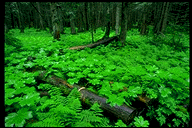How I got rich and famous (or at least famous) on the Internet
by Philip Greenspun, part of photo.net.
The computer has been around for fifty years but it hasn't
fundamentally changed the lives of most photographers or, for
that matter, most people. If your job in 1950 was writing
payroll checks, then the computer probably changed your daily
life, but most people get through most parts of their day without
relying on a computer. Why won't that be true in 50 years?
Because of the network.
James Watt's 1765 steam engine didn't change your life unless you
were pumping water out of coal mines. When that steam engine got
mounted on rails and railroads were spread across nations,
society was transformed. With the railroad came the ability to
serve a national market with one factory. Factories grew
enormous and pulled people out of the countryside to work inside.
The computer is the steam engine. The network is the railroad.
 Steam engine, railroad, fish, or fowl, the digital world never had much
impact on my pictures. Since 1986, I've specialized in medium and
large-format advertising, nature, and travel photography. No camera was
too big, no tripod too heavy, no film too slow to stop me from trying for technical perfection.
Digital technology had nothing to offer me, even though I was surrounded
by it whenever I went to my "Day Job" office at the MIT Laboratory for
Computer Science. If my photography and magazine writing weren't
improved by doing computer science research, at least being at the lab
that developed Internet gave me a head start on high-bandwidth
networking. I started on Internet in 1976, when Internet was still
called ARPAnet, but it was only in 1994 that the network breathed life
into my creative business, which had fallen on hard times.
Steam engine, railroad, fish, or fowl, the digital world never had much
impact on my pictures. Since 1986, I've specialized in medium and
large-format advertising, nature, and travel photography. No camera was
too big, no tripod too heavy, no film too slow to stop me from trying for technical perfection.
Digital technology had nothing to offer me, even though I was surrounded
by it whenever I went to my "Day Job" office at the MIT Laboratory for
Computer Science. If my photography and magazine writing weren't
improved by doing computer science research, at least being at the lab
that developed Internet gave me a head start on high-bandwidth
networking. I started on Internet in 1976, when Internet was still
called ARPAnet, but it was only in 1994 that the network breathed life
into my creative business, which had fallen on hard times.
Working for magazines was like a crack habit. I got really high
the first time my work appeared in a national magazine. I made
50 copies and sent them to friends. Each subsequent job provided
less of a buzz. My work was gone and forgotten after a month and
I needed the next fix. I began to notice that I couldn't tell
stories the way I wanted. Most magazines need it short and
upbeat and they don't want to pay for too many color separations.
I wanted to write long and true with lots of pictures. What was
worse, I was tired of selling myself.
My theory is that every person is granted at birth a fixed number
of strangers whom he can approach and try to sell something. I
had used mine up without realizing it, so I couldn't even bring
myself to talk to reps or stock agencies. I kept doing
advertising work for old clients, but even as my work got better,
buyers were forgetting about me.
My career turned around one brisk fall day in 1993 when I typed
"mosaic" on a UNIX workstation at MIT. A document appeared with
text and color pictures mixed together, just like a magazine
page. I clicked the mouse on a word and a page appeared from a
computer in Australia. Another click brought up a video clip
from France. Clicking on a small picture made it grow into a
large picture. Without knowing how to do more than click a
mouse, I could grab and view about 30 different kinds of
documents from over a million servers around the world. I had
discovered the World Wide Web and, although it contained almost
no new technology, it was the most exciting thing I'd seen in
computer science for 15 years.
One thing about Internet that users of America OnLine and
CompuServe have a hard time understanding is that Internet is a
peer-to-peer network; any service that I could use I was also
capable of delivering. Consumer computer networks recapitulate
the relationship between publisher and reader that has existed
ever since Gutenberg: Big guys write; little guys read. Sure,
you can upload a file to AOL, but that is the electronic
equivalent of Xeroxing 100 copies of your work and mailing it to
friends. On Internet, every user's machine can publish back to
the network on a roughly equal basis. The machine on my desk,
for example, was capable of shipping out nearly 10 million bits
of data every second to the Internet; at the time, that seemed
ample for telling the story of the summer I spent driving across
North America.
 Six months before, I'd driven from Boston to Alaska and back,
writing a 10-page story every week about the people I'd met.
After I finished editing each story on my Macintosh PowerBook,
nicknamed "Samantha," I'd email it to about 100 friends worldwide
and also post it to rec.travel, an Internet bulletin board that
is read by perhaps 10,000 people/day. I therefore already had
sufficient text for a Web book: Travels with Samantha (after
Steinbeck's Travels with Charley). What I needed were pictures.
Although I hadn't been very serious about photography while on
the road (because I had no buyers lined up), I did manage to pull
together 250 decent illustrations for the book, which I had
scanned to PhotoCD. The fact that I'd been too lazy to take a
lot of medium and large-format images worked to my advantage; it
costs about $1 to put a 35mm slide onto CD and $15 for a 6x6cm
chrome.
Six months before, I'd driven from Boston to Alaska and back,
writing a 10-page story every week about the people I'd met.
After I finished editing each story on my Macintosh PowerBook,
nicknamed "Samantha," I'd email it to about 100 friends worldwide
and also post it to rec.travel, an Internet bulletin board that
is read by perhaps 10,000 people/day. I therefore already had
sufficient text for a Web book: Travels with Samantha (after
Steinbeck's Travels with Charley). What I needed were pictures.
Although I hadn't been very serious about photography while on
the road (because I had no buyers lined up), I did manage to pull
together 250 decent illustrations for the book, which I had
scanned to PhotoCD. The fact that I'd been too lazy to take a
lot of medium and large-format images worked to my advantage; it
costs about $1 to put a 35mm slide onto CD and $15 for a 6x6cm
chrome.
One of the nice things about Web publishing is that all of the
tools are free. There are free servers, clients, and tools for
Macintoshes, PCs, and UNIX workstations. I used free tools to
automatically convert my text from Microsoft Word into HyperText
Markup Language (HTML), which is the lingua franca of the Web,
and my pictures from PhotoCD into GIF and JPEG, the compressed
formats that transmit quickly. After about three weeks of
evenings, my Web opus was ready to give away.
Only about 100 readers/day came to look at Travels with Samantha at
first. I got an email message every day or two thanking me for
enriching someone's life. By June, 1994, the book had been out for
three months and I'd gotten enough thoughtful letters that I felt that
publishing on the Web was the most rewarding thing I'd ever done. The
letters inspired me to prepare Berlin/Prague and New Zealand travelogues, plus add older writings on
photography and computer science. When a friend's brother, an MIT
undergraduate, was prosecuted for Wire Fraud I started a legal defense fund for him on the Web. I published
all the documents in the case and wrote software to accept pledges
electronically. [The fund ultimately raised about $8000 and the case
against David LaMacchia was dismissed on December 29, 1994.]
None of this earned me any money, of course, but I was learning
what my work meant to people. When I publish in a magazine, the
circulation numbers may say that 500,000 copies were printed, but
I seldom get more than a handful of phone calls or letters.
Readers got my story and paid $2.95 for it; transaction complete.
On the Web, though, readers get my stories for free so they
apparently feel they owe me something in return.
June 1994 brought new client programs for PCs and Macintoshes that
substantially broadened Web readership and a Best of the Web '94 award
for Travels with Samantha. Accesses soared to
600 readers on busy days, flattened back to 200 or so per day and then
climbed back to a steady 600/day again by November, 1994. That was
about the time that cumulative readership crossed 90,000 and that
something very strange happened: I began to make money.
I thought I was saying goodbye to the ugly world of commerce by putting
my work on the Web. Eventually, of course, the Web will have a
mechanism similar to that of 900 numbers and there will be ways of
collecting a few pennies from each reader. However, there isn't one now
and I have yet to collect a dime from a reader (though I get requests
all the time from people who want to buy a hardcopy of Travels with Samantha). What happened is that I
inadvertently became a stock photo agency.
 A young Dutch graphic artist sent me email from Holland. He
wanted a photo of a bear catching a salmon for a short-run
catalog. All the stock agencies he'd tried wanted $1000. Would
I let him use one of mine for $125? A start-up Russian-American
CD-ROM publisher wanted some images of American cities. Could
they pay me $1000 for their first run of 5000 and 20 cents/disk
afterwards?
A young Dutch graphic artist sent me email from Holland. He
wanted a photo of a bear catching a salmon for a short-run
catalog. All the stock agencies he'd tried wanted $1000. Would
I let him use one of mine for $125? A start-up Russian-American
CD-ROM publisher wanted some images of American cities. Could
they pay me $1000 for their first run of 5000 and 20 cents/disk
afterwards?
After two months, I had five photo requests and one assignment
and was about $5000 richer for them. I was amazed by what a
difference a couple of months made but even more amazed that
these people found my work at all. Internet and the Web are
great for serendipitous information discovery, but if you are
looking for something specific, it is like walking into the
Library of Congress the day after the card catalog burned. My
web site is no different. I have about 2000 photographs on-line,
but they are buried among hundreds of pages of stories and
sometimes the most interesting photographs are only presented to
the curious reader who follows every last little hyperlink.
Right now I'm working on software to automate the maintenance of
indexed stock photo archives. When it is finished, a buyer will
be able to submit a query over Internet and my server will
assemble a page of thumbnails, possibly from 100 different Web
sites around Internet. Each thumbnail will link to a large JPEG
for evaluation and the photographer's email address for
negotiation.
Even after I've finished this software, I'm not going to sit and wait for the
dream assignment from Saatchi and Saatchi to land in my email box.
Buyers on Internet are looking for lower prices than they'd get from
traditional vendors, but that's as it should be. Internet connects
buyers and photographers directly. There isn't much point in all of
this fancy technology if it doesn't make transactions more efficient.
If the money hasn't been fantastic so far, I comfort myself with two
thoughts: (1) I expected nothing and got thousands of dollars, (2) Web
traffic is growing 25% per month-if my revenues grow at the same rate,
I'll be richer than Bill
Gates in five years.
Sound a little too good to be true? Let's look at some of the pitfalls
of Web publishing for the average photographer. The most serious is the
lack of standards in the world of digital imaging. If you edit your
pictures to look great on your Macintosh in Los Angeles, they will
probably look too dark on a UNIX box in France. Maybe you have a dark
room and a monitor white point of 6500 K; your customer has an
improperly adjusted monitor, under fluorescent lights, with a white
point of 9300 K. In the worst case, your customer will have an 8-bit
screen and all 10 of your thumbnails will be forced to share one
256-color palette. They will all look terrible and the potential
customer may turn away without ever knowing that it wasn't your fault.
Unfortunately, until new standards are promulgated, there is no solution
to this problem. I could write a whole article on the subject of gamma,
but suffice it to say that if you prepare your work on a Macintosh with
gamma set to 2.2, your work may look decent on PCs and Unix machines but
will definitely be washed out on the average Macintosh. If you prepare
your work on an average Macintosh, it will look too dark and contrasty
on other kinds of machines.
Second is the problem of copyright. The biggest part of this problem is
answering email from people asking how you keep your images
from getting stolen once they are out on the Net. I tell them "the same
way I keep them from getting stolen once they are printed in a magazine;
I don't." Internet will save someone the trouble of scanning a magazine
page, of course, but the vast majority of buyers would rather pay you.
In addition to freedom from legal worries, they want to obtain a higher
quality image from PhotoCD or the original chrome than they could get by
using the compressed JPEGs on the Web.
 In some ways the most time-consuming problem for me has been dealing
with the large number of magazines that want to reprint my photographs
in stories about the Internet. None of them want to pay, of course, and
that means that they won't necessarily put much thought into
reproduction quality. I spend a few hours every month lecturing editors
on how it is essential that they capture my Web pages from 24-bit
screens and that if they want to run any larger images they have to pay
me for a dupe chrome or PhotoCD. My two worst experiences with the Web
fall into this category. Forbes reprinted the cover of Berlin and Prague: Nazis, Jews, stamp collectors, and
beautiful women without asking permission and they captured the page
from an 8-bit PC screen. Lawyers could argue for months over whether
this was fair use or not, but the bottom line is that the four pictures
looked bad enough that I don't expect to be shooting the annual report
for any company whose CEO read that issue carefully.
In some ways the most time-consuming problem for me has been dealing
with the large number of magazines that want to reprint my photographs
in stories about the Internet. None of them want to pay, of course, and
that means that they won't necessarily put much thought into
reproduction quality. I spend a few hours every month lecturing editors
on how it is essential that they capture my Web pages from 24-bit
screens and that if they want to run any larger images they have to pay
me for a dupe chrome or PhotoCD. My two worst experiences with the Web
fall into this category. Forbes reprinted the cover of Berlin and Prague: Nazis, Jews, stamp collectors, and
beautiful women without asking permission and they captured the page
from an 8-bit PC screen. Lawyers could argue for months over whether
this was fair use or not, but the bottom line is that the four pictures
looked bad enough that I don't expect to be shooting the annual report
for any company whose CEO read that issue carefully.
The second experience was with a start-up Japanese magazine devoted
exclusively to the Internet. They wanted to include 50,000 copies of Travels with Samantha on CD-ROM with their first
issue. They'd be collecting $1 million in revenue for this and wanted
to give me... nothing. Oh, and would I mind spending a few days
collecting up the files, decoupling the book from the UNIX servers (some
of the pages are generated on-the-fly by programs), and testing the
derivative edition?
This magazine outlined in sharp detail an all-too-common
businessperson's attitude toward Internet: a bunch of yokel nerds spent
25 years building this thing and sharing with each other, too naive to
see how much money was in it; all I have to do is wade in, grab
something, and sell it for big bucks. Many people come to Internet and
their first thought is "what can I get out of this right now?" The
network is so young that, in addition to being rather rude, this
probably isn't a profit-maximizing strategy. The people that will make
money on the Internet in the long run are probably those that start out
asking "what can I give people?"
That's how I started out on the Web. I gave away my pictures. I gave
away my stories. I gave away advice and software that I wrote to
"competitors." The Web gave me back a large and growing audience for
my work. The Web gave me back money (though I ultimately decided to
give most of that away). The Web gave me back mail like this...
"Thanks for getting me thru some sloooow weekends at work.
.... I have been working all the holiday weekends here at
Directory Assistance & I wouldn't have made it out alive
without your book. Thanks for sharing."
-- Mary in Wisconsin
"I love your book for two reasons. First, it's great, the
story is fresh and honest. The second is of course that it
is the kind of thing that this technology has been building
for - it some how makes all those millions of dollars spent
on computers, on the net, on decades of development seem
like there might have been a reason for it all. Thanks for
the warm glow."
-- Jonathan in New Zealand
Note: This story was adapted from one I wrote for the July 1995 issue
of Photo District
News.
 Moeraki Boulders, South Island, New Zealand
Moeraki Boulders, South Island, New Zealand
philg@mit.edu
Add a comment | Add a link
 Steam engine, railroad, fish, or fowl, the digital world never had much
impact on my pictures. Since 1986, I've specialized in medium and
large-format advertising, nature, and travel photography. No camera was
too big, no tripod too heavy, no film too slow to stop me from trying for technical perfection.
Digital technology had nothing to offer me, even though I was surrounded
by it whenever I went to my "Day Job" office at the MIT Laboratory for
Computer Science. If my photography and magazine writing weren't
improved by doing computer science research, at least being at the lab
that developed Internet gave me a head start on high-bandwidth
networking. I started on Internet in 1976, when Internet was still
called ARPAnet, but it was only in 1994 that the network breathed life
into my creative business, which had fallen on hard times.
Steam engine, railroad, fish, or fowl, the digital world never had much
impact on my pictures. Since 1986, I've specialized in medium and
large-format advertising, nature, and travel photography. No camera was
too big, no tripod too heavy, no film too slow to stop me from trying for technical perfection.
Digital technology had nothing to offer me, even though I was surrounded
by it whenever I went to my "Day Job" office at the MIT Laboratory for
Computer Science. If my photography and magazine writing weren't
improved by doing computer science research, at least being at the lab
that developed Internet gave me a head start on high-bandwidth
networking. I started on Internet in 1976, when Internet was still
called ARPAnet, but it was only in 1994 that the network breathed life
into my creative business, which had fallen on hard times.



 Moeraki Boulders, South Island, New Zealand
Moeraki Boulders, South Island, New Zealand